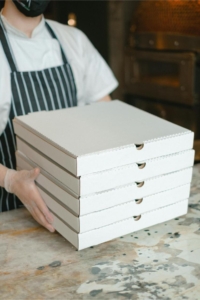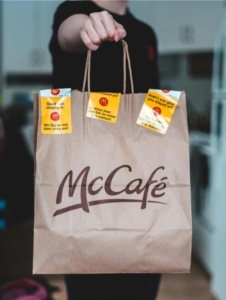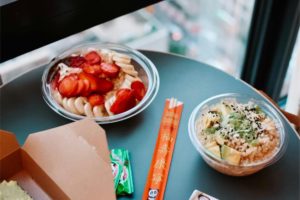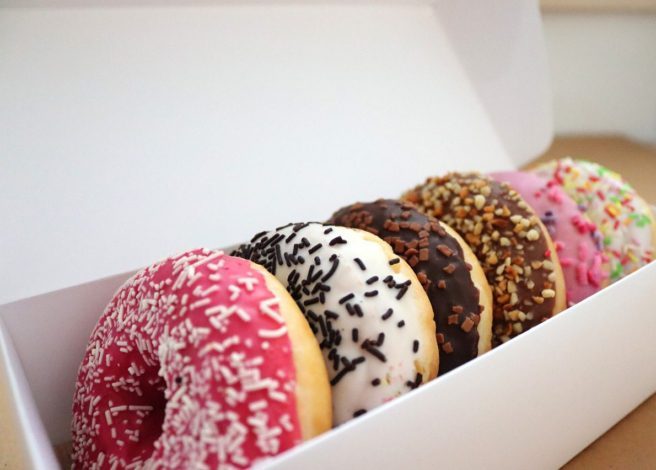Listen to the audio recording of this blog post or check out the featured Podcast about this topic.
At a Glance
- Choosing between plastic or paper means weighing cost, performance, and sustainability trade-offs — paper is often pricier and less protective for fresh foods.
- Plastic offers superior barrier protection, reducing spoilage and food waste compared to paper wraps.
- Paper may lead to higher packaging and handling costs, and often lacks moisture resistance.
- Hybrid approaches (plastic lined paper) can help balance eco-appeal with functionality and shelf life.
Paper of plastic? The packaging debate has exploded beyond grocery aisles — now it’s cutting into food business’ bottom lines. The eco-minded crowd wants paper for everything because it’s recyclable, biodegradable, and made from renewable resources like trees. But, savvy business owners find that using paper packaging may hurt their profits.
What began as a good effort for “greener” packaging has become a cautionary tale. There are hidden costs, operational problems, and an ironic turn in the sustainability story.
With over 50 years in the packaging industry, we’ve seen trends come and go. Few myths are as persistent as paper’s “eco-friendly” reputation. Let’s “unwrap” the truth about plastic versus paper packaging.
Decades of experience show that sustainability isn’t as clear-cut as it’s made out to be. We will uncover the truth about what matters for your food business’s profits. It’s important to examine costly misconceptions and practical realities. The truth is, sometimes “going green” can leave you seeing red on your balance sheets.
This article will examine critical issues we’ve uncovered:
- Visibility
- The Hidden Costs
- Operational Efficiency
- Product Quality and Protection
- Health Concerns
- Sustainability Pros and Cons
Ready? Let’s get packin’!
1. Visibility
The visibility factor ranks high when diving into the problems associated with paper food packaging. The fundamental principle of retail is simple: customers buy with their eyes. 
This was starkly illustrated when a major grocery chain switched its bakery items to black paper boxes with small windows (note: These small windows are made from plastic, not paper). The result? A notable drop in sales prompted a swift return to clear plastic packaging. The reason became obvious: customers could barely see the products they were meant to buy.
This visibility issue particularly affected impulse purchases — a crucial revenue stream for bakery departments. Customers who can’t clearly see appetizing pastries and baked goods are less likely to make unplanned purchases. In grocery stores, split-second decisions drive sales. In fact, a German study found that you have 2.5 seconds to grab a consumer’s attention. So, packaging visibility can make or break a product’s success.
The truth is plain and simple: plastic can be clear, but paper cannot. Customers need a 360-degree view of the contents inside the package. How can you, as a business owner, merchandise a product that your customers cannot see?
2. Understanding The Hidden Costs
While basic paper packaging may appear less expensive at first glance, the true cost runs far deeper than the price per unit. Let’s do the math. While paper packaging may seem like a simple, cost-effective choice, it often requires additional materials and treatments to meet functional and aesthetic needs, adding cost and reducing recyclability. Here’s what goes into making a typical paper food container work effectively:
- Specialty coatings are required to prevent liquids from seeping through paper packaging, ensuring durability and cleanliness. Moisture-resistant liners are essential for maintaining food freshness and preventing sogginess.
- Transparent plastic window films are often added to improve product visibility, enhancing customer appeal.
When these additions are factored in, the total cost of a paper box can be comparable to — or even exceed — that of a plastic alternative. If a business wants to add its own custom branding, that “economical” paper box suddenly costs as much as, or more than, its plastic counterpart.
However, the true cost extends beyond just materials. Storage is a key factor — while flat-packed boxes save space initially, there is additional expense with labor required to assemble them. Waste is another consideration, as damaged or moisture-compromised boxes may become unusable, and torn windows can reduce their effectiveness for display. Without sufficient protection, products may be more prone to spoilage from shorter shelf lives, ultimately increasing the cost per successful delivery.
3. Operational Efficiency
 Paper packaging can impact operational efficiency. It typically requires less storage space in its flat, unassembled state, though it demands additional labor for assembly, as seen with coffee cup carriers that arrive flat but need folding before use.
Paper packaging can impact operational efficiency. It typically requires less storage space in its flat, unassembled state, though it demands additional labor for assembly, as seen with coffee cup carriers that arrive flat but need folding before use.
In contrast, plastic packaging arrives pre-assembled and ready for immediate use, saving preparation time. Plastic options like stackable clamshells provide efficient storage solutions and offer superior durability and moisture resistance. However, plastic generally requires more initial storage space in its pre-constructed form. The optimal choice between paper and plastic ultimately depends on a business’s specific operational workflow, storage capacity, and customer preferences, with each material presenting its own set of practical tradeoffs that affect day-to-day business operations.
4. Product Quality and Protection
Product quality and protection present another challenge with paper packaging. Paper has a few major drawbacks in this area, including:
Interactions with moisture: Paper can draw moisture from baked goods without proper lining (the linings are another problem — don’t worry, we’ll get to it). This speeds up staleness and reduces shelf life. You read that correctly: paper packaging can draw moisture from your products. How does that affect baked goods? You may be better off advertising those (once) “muffins” as “scones.” This moisture issue isn’t just about product quality — it directly affects waste levels and profit margins.
Paper’s structural limitations: Paper requires thicker material to match plastic’s protective qualities. Even then, durability issues can lead to increased product damage during transport and handling. 
Tamper evidence: While paper packaging can offer such options as tamper-evident labels or tape, these can easily be removed. Someone could rip off the staple or tape, grab a dumpling with their bare hands, and reseal the package (try not to panic). What does that say about the safety of your food, the possibility of contamination, and worse, the health of your customers?
5. Health Concerns
Paper packaging may pose certain health risks to consumers. One concern is the use of inks in printing on paper packaging. While these inks are supposed to be food safe, how can you know for sure?
Some not-food-safe inks can contain harmful chemicals, such as heavy metals and volatile organic compounds (VOCs), which may migrate into food products and pose health risks.
Another significant concern is the presence of per- and polyfluoroalkyl substances (PFAS) in the lining of some paper packaging. PFAS are used to make packaging resistant to grease and moisture, but they are known to be persistent in the environment and can accumulate in the human body over time. Exposure to PFAS has been linked to various health issues, including hormone disruption, immune system effects, and an increased risk of certain cancers.
6. Sustainability Pros and Cons
The debate between paper and plastic products is complex, with both materials having their own environmental impacts. While paper is often perceived as more environmentally friendly, the reality involves various factors that need to be considered.
Pros
Recyclability: Paper products are highly recyclable (without liners), which helps reduce waste and the need for virgin materials.
Procurement: Made from trees, paper is a renewable resource that can be sustainably managed through responsible forestry practices.
Biodegradability: Paper breaks down naturally and minimizes its environmental impact, if disposed of properly. This is untrue when it is mixed with components like plastic film windows, causing the products to end up in anaerobic (oxygen-deprived) environments like landfills, producing methane gas.
Versatility: Paper is used in a wide range of applications from packaging to printing. If you’re looking for packaging for a product that has little to no moisture (such as nuts), paper might be right for you.
Cons
Energy usage: It can be resource-intensive, requiring significant amounts of water and energy.
Deforestation: Unsustainable forestry practices can lead to deforestation and loss of biodiversity.
Cost: Paper products generally have a shorter lifespan compared to some plastic alternatives and can be more expensive.
Environmental considerations: Paper has a larger carbon footprint in the production phase compared to plastic. Many paper food packages have non-recyclable liners or windows, which can contaminate the recycling stream and contribute to landfill waste. Despite consumers’ best intentions, these non-recyclable components often end up in landfills, undermining the sustainability of paper products.
The Business Case for Clear Plastic Packaging
 In the food industry, especially in retail, clear plastic packaging proves its worth through:
In the food industry, especially in retail, clear plastic packaging proves its worth through:
- Allowing products to market themselves. It drives impulse purchases and boosts sales.
- Extending shelf life. Good plastic packaging keeps products fresh longer. It cuts waste and extends their selling time.
- Saving on labor costs. Ready-to-use containers need no assembly. They also protect goods during transport and handling.
- Environmental considerations: Plastic packaging uses less energy to make than paper. It also has a smaller carbon footprint.
Paper Vs. Plastic: The Choice is Yours
Like many trends, packaging cycles between materials. Companies learn the real effects of their choices over time. While regulations and consumer views may favor paper packaging today, smart businesses look at the total impact, not just first impressions.
There is no winner or loser in the comparison of plastic and paper packaging. If you’re looking for packaging that is clear, light, durable, and can contain elements of tamper-protection and leak resistance, plastics are the right choice. If you’re looking for packaging that takes up less space pre-assembly, biodegrades under the right conditions, and can hold dry elements like nuts, seeds, or shelf-stable pasta, paper may be the way to go.
The true cost of any packaging choice goes beyond what you might expect. When you add up the labor, waste, product protection, and environmental impact — it’s often different from what you’d guess. Maybe it’s time to test different options and see what actually works best for your business.
Do you want to know more about material options? Visit our Learning Center today and start exploring!

